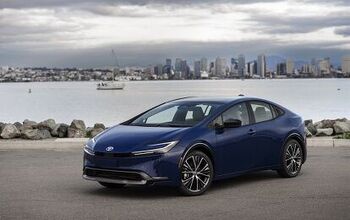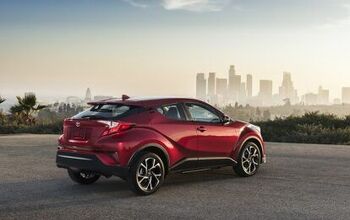Toyota Not Bold Enough?
This morning’s Automotive News [sub] carries a highly critical report on Toyota’s reaction to the worldwide automotive meltdown. The bottom line: the Japanese automaker is too damn slow and overly cautious. “Toyota Motor Corp. is famed for its advance planning, obsessive attention to ‘what if’ scenarios and continuous improvement,” Hans Greimel writes. “Yet with the market collapsing, the world’s top automaker is stunned to a near standstill by an astonishing plunge from record profits to record losses in 12 short months.” That’s quite a statement, especially as it seems to be based on a single analyst’s analysis. Greimel trots out JPMorgan’s Takaki Nakanishi, who complains that there’s “nothing remotely innovative” in ToMoCo’s recent plans to cut $5.11 billion in fixed costs by the end of the year. What, no feng shui?
“The company has not made any attempt to address the core strategic elements of production structure realignment or its product, regional and platform profile,” Nakanishi said.
By comparison, Nissan is dumping 12 new models that had been planned for the next five years. It also plans more production abroad to counter the effects of the soaring yen.
So Toyota’s decision not to cut its investment in new models—or at least publicly announce it—is a weakness? You could see it as a sign of strength. You know, if you were so inclined. Nor does the following assertion strike me as the truth about Toyota.
“Exports are an unaffordable luxury now,” said Christopher Richter, an analyst at CLSA Asia-Pacific Markets. Toyota should close plants at home and move volume overseas, he said.
“The time to fix it is now when you have all of your factories in the world operating under capacity,” Richter said. Toyota could boost profits by slashing its ratio of imported cars in America to 9 percent, from a current level of 45 percent, with minimal investment, he estimated.
Apparently, Toyota is . . . waiting.
[Incoming President] Akio Toyoda has pledged to be “as bold as possible in pushing ahead with reforms.”
The problem is that he’s not president yet. And current President Katsuaki Watanabe is unlikely to announce major overhauls before the changeover, for a couple of reasons.
First, the current boss doesn’t want to saddle the next one with any policies that may backfire. Second, he doesn’t want to steal Toyoda’s thunder as leader of the company’s comeback.
So Toyota’s current boss is playing CYA, and the company lets personal politics interfere with its survival. No sense of urgency? Toyota as the new GM? Anyway, Greimel is no stranger to CYA, as his backpedalling conclusion demonstrates.
As cautious as Toyota’s approach is, there are signs that change is afoot.
In late February, the company said it is bringing back Yoshi Inaba, 62, the former U.S. sales chief who left the automaker to run an airport. He will join Toyoda’s administration in June and oversee North American projects. The company hasn’t given details.
A few days later, Toyoda pushed aside three executive vice presidents who had led the company through its rapid expansion—including Kinoshita, who will retire in June.
More by Robert Farago
Latest Car Reviews
Read moreLatest Product Reviews
Read moreRecent Comments
- Dave Holzman My '08 Civic (stick, 159k on the clock) is my favorite car that I've ever owned. If I had to choose between the current Civic and Corolla, I'd test drive 'em (with stick), and see how they felt. But I'd be approaching this choice partial to the Civic. I would not want any sort of automatic transmission, or the turbo engine.
- Merc190 I would say Civic Si all the way if it still revved to 8300 rpm with no turbo. But nowadays I would pick the Corolla because I think they have a more clear idea on their respective models identity and mission. I also believe Toyota has a higher standard for quality.
- Dave Holzman I think we're mixing up a few things here. I won't swear to it, but I'd be damned surprised if they were putting fire retardant in the seats of any cars from the '50s, or even the '60s. I can't quite conjure up the new car smell of the '57 Chevy my parents bought on October 17th of that year... but I could do so--vividly--until the last five years or so. I loved that scent, and when I smelled it, I could see the snow on Hollis Street in Cambridge Mass, as one or the other parent got ready to drive me to nursery school, and I could remember staring up at the sky on Christmas Eve, 1957, wondering if I might see Santa Claus flying overhead in his sleigh. No, I don't think the fire retardant on the foam in the seats of 21st (and maybe late 20th) century cars has anything to do with new car smell. (That doesn't mean new car small lacked toxicity--it probably had some.)
- ToolGuy Is this a website or a podcast with homework? You want me to answer the QOTD before I listen to the podcast? Last time I worked on one of our vehicles (2010 RAV4 2.5L L4) was this past week -- replaced the right front passenger window regulator (only problem turned out to be two loose screws, but went ahead and installed the new part), replaced a bulb in the dash, finally ordered new upper dash finishers (non-OEM) because I cracked one of them ~2 years ago.Looked at the mileage (157K) and scratched my head and proactively ordered plugs, coils, PCV valve, air filter and a spare oil filter, plus a new oil filter housing (for the weirdo cartridge-type filter). Those might go in tomorrow. Is this interesting to you? It ain't that interesting to me. 😉The more intriguing part to me, is I have noticed some 'blowby' (but is it) when the oil filler cap is removed which I don't think was there before. But of course I'm old and forgetful. Is it worth doing a compression test? Leakdown test? Perhaps if a guy were already replacing the plugs...
- Crown No surprise there. The toxic chemical stew of outgassing.


































Comments
Join the conversation
Bunter1 : March 2nd, 2009 at 12:35 pm Stewart Dean-The big oops at Pearl (for the Japanese) was that the carriers were not at home. It turned out that battlewagons were history and airpower was everything. Adm. Yamaoto did note that “I am afraid we have awakened a sleeping giant”. Also, a third Japanese attack wave that was scheduled at Pearl Harbor was called off. Had that third wave gone down as planned, it would have allowed the Japanese to bomb and destroy the rows of large land based oil tanks at PH (thus crippling ALL US Navy ships in the Pacific). The Japanese also could have conducted submarine attacks of US oil tankers from Long Beach to Pearl Harbor, thus crippling our Navy for far longer than the 6 months or so that it took us to bounce back and go on the offensive. Now back to cars.